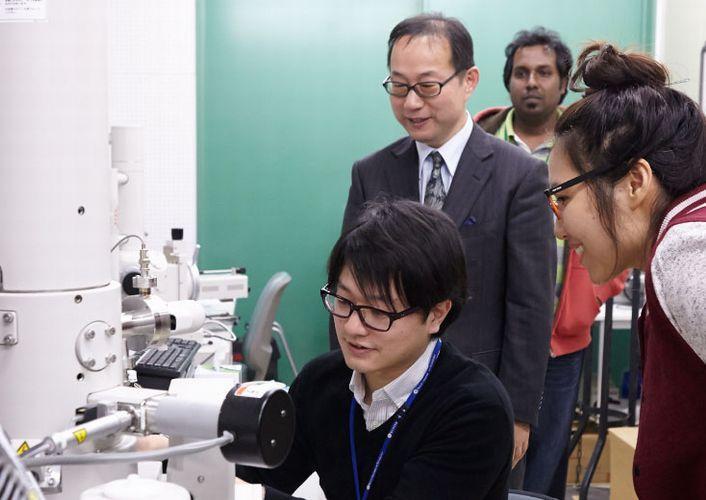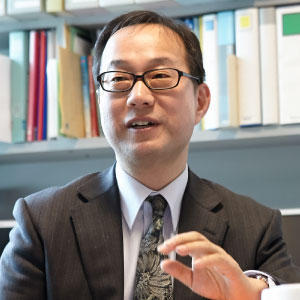- TOP
- Cutting-edge Research and Social Contribution
- Cutting-edge Research
- Established: a method for large scale synthesis of unique and beautiful metal oxide nanoparticle assemblies with porous morphology

Established: a method for large scale synthesis of unique and beautiful metal oxide nanoparticle assemblies with porous morphology

KOBIRO Kazuya
- Specialized field
Synthetic organic chemistry, supramolecular chemistry, nanoparticle science
Development of a super rapid method of synthesizing titanium dioxide, a typical photocatalyst
Photocatalysts are catalytic substances that change their surroundings when light hits them without changing themselves. One of the most widely used photocatalysts is titanium dioxide, which is inexpensive and harmless to living organisms. When titanium dioxide is irradiated by sunlight, electrons are generated; this decomposes harmful substances and dirt, and at the same time, the surface becomes more compatible with water due to its high hydrophilicity. As a result of these excellent characteristics, titanium dioxide has attracted very strong interest from the viewpoint of energy and environmental conservation. In particular, porous materials, with their very large surface area, are expected to be utilized in a wide range of applications.
In 2012, Professor Kobiro, together with Associate Professor Wang Pengyu, developed an epoch-making method for ultra-high speed synthesis of porous titanium dioxide nanoparticle assemblies. The conventional synthesis method requires complicated operations and a long reaction time; however, the new method simply adds titanium isopropoxide as a raw material and carboxylic acid as an auxiliary to methanol and heats the mixture to 300-400° C. The synthesis time is only 10 minutes. Furthermore, this synthesis method has been used to successfully create not only solid structures but also hollow structures.
The key to that success was the use of methanol at high temperature and under high pressure. Prof. Kobiro and Dr. Wang Pengyu (who had been conducting research together on organic synthesis reactions using water a high temperature and high pressure water, called supercritical water) employed supercritical water, which proved successful. Since the nanoparticles created have a shape very similar to marimo (a round green alga), they named it MARIMO (Mesoporously Architected Roundly Integrated Metal Oxide). Now they are conducting applied research in their MARIMO project.
Prof. Kobiro says, "Our creation of the porous spherical aggregate of titanium dioxide was not a world first; it has been done many times. However, the difference between our creation and those of others is the fineness of the irregularities on the surface. Very fine particles clustered and became spherical. That is really beautiful, and I was very happy when I first saw it. In addition, various materials can adhere to the surface thanks to its irregularities. It's obvious that this will have a wide range of applications."
Collaboration with enterprise: Realization of mass synthesis, indispensable for practical applications
Having discovered the possibilities of this technology, Prof. Kobiro started working toward practical applications with Associate Professor (then lecturer) Otani, first aiming at mass synthesis. In 2013 they began collaborative research with UJIDEN Chemical Industry, Co., Ltd. (Kochi Prefecture), and developed a reaction device that can synthesize porous metal oxide nanoparticles continuously. Then in 2015, their effort enabled the large-scale synthesis essential for practical use. In the case of porous titanium dioxide nanoparticles, they achieved production of 200 g per day.
Prof. Kobiro explains, "Until then production was limited to 10 mg at time, but we found a way to synthesize 200 g at one go, and established stable production technology. This was not simply a matter of increasing the amount of raw material; we had a string of failures, day after day. It took us a year and a half to succeed. When we finally made it, we jumped for joy," he recalls, laughing.
They succeeded in synthesizing not only titanium dioxide but also porous nanoparticles of titania, silica, zinc oxide, zirconia and ceria. Currently their process has evolved into technology that can synthesize various metal oxides as spherical porous nanoparticles. In addition, they achieved the synthesis of a combination of oxides, so it became possible to make: a) uniformly dispersed multiple metal oxides; b) domain type mixed multiple metal oxides with mottling; and c) core-shell type oxides which have a center separate from the surface. They also found a means of finishing the materials with perfect flexibility.
Prof. Kobiro continues, "I think my job is to understand the feelings of substances and reactions, things that can never speak, and translate them into words. It was an accidental result to achieve that form with titanium dioxide by means of a simple reaction, but it was really just a reflection of the character of the material. So if I try to achieve this with other materials I cannot use the same method. I need to consider the feelings of the material. In fact, regarding MARIMOization of metal oxides aside from titanium dioxide, the simplicity of the reaction is the same but the things that we need to add or to combine are quite different. This turned out to be a difficult point."
It is also worth noting that nanoparticles of unprecedented shape have been created one after another through the application of this synthesis method. Prof. Kobiro has synthesized nanoparticles of gold, platinum and palladium, hollow porous titanium dioxide nanoparticles with a nested type structure, and nanoparticles like 'matryoshka' dolls.
Prof. Kobiro says, "It is thought that during the reaction process, noble metal ions penetrated the hollow porous aggregate of titanium dioxide nanoparticles and were then reduced by high temperature methanol and formed alloy particles, which were trapped inside. Small particles could then be inserted through a narrow opening. You could say that in the nano world we have created a kind of ship in a bottle, where the structure is created internally by inserting small particles through an opening in the narrow end."
When measuring the density of particles obtained by cutting round cross-sections, distinct layers of gold, platinum and palladium were created in the center. It was confirmed that they were covered with a layer of titanium dioxide alloy particles, which partitioned off the space.
Prof. Kobiro continues, "This is an effective way to achieve wrapping with very light materials under conditions where if the particles make direct contact with metal, they will be broken. This catalytic reaction takes place without ever contacting the outside of the particles, so it will not break them."
The team also succeeded in creating all sorts of shapes of gold, platinum and palladium alloy nanoparticles separately, using a simple unit chemical process. For example, in their successful synthesis of a uniformly dispersed material, synthetic nanoparticles of gold, platinum and palladium adhered to the outer surface of the solid porous titanium dioxide nanoparticles. The world of MARIMO is expanding beyond the range of our imagination.
New possibilities hidden beyond the humor and the beauty
Prof. Kobiro is eager to further increase the variety of these unique and beautifully shaped porous metal oxide nanoparticles. That is his goal as a chemist.
He says, "I find beauty greatly appealing, and it's a lot of fun to create beauty with my own hands. It might sound snobbish but just like a musician expresses himself by playing a musical instrument, for example, a chemist expresses himself by using materials to create beautiful and useful things which impress people strongly. In that sense, materials are rather like musical instruments. The beauty of shapes, concepts and reactions is fascinating."
The pursuit of unique and beautiful chemistry creations will eventually lead to new discoveries that are useful to humanity. Now porous metal oxide nanoparticles are available for a wide range of practical applications such as photocatalysts, drug and gene delivery agents, high performance abrasives, and thermal barrier coatings.
Prof. Kobiro says, "I'd like to do something original, something outstanding with nanoparticles of various shapes. One of my goals is to develop nanoparticles for use as catalysts. I am convinced that composite nanoparticles embedded in spherical nanoparticle porous aggregate will be high performing catalysts. If this idea turns out to be correct, chemical reactions could be much more efficient and their energy efficiency might be improved dramatically. Although it may be a bit of an exaggeration, I am expecting that we might see something close to an energy revolution that could change the world. As we pursue those goals, there will surely be many obstacles to overcome, but in principle there is no real obstacle. I am certainly sure that I can do this, so I will work on it and see what happens!"
